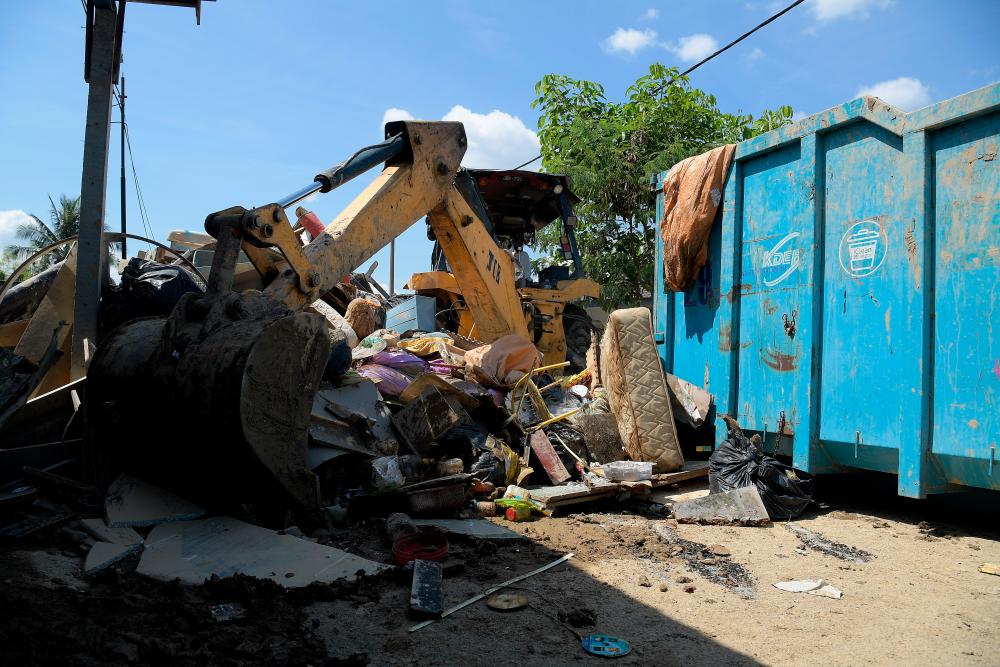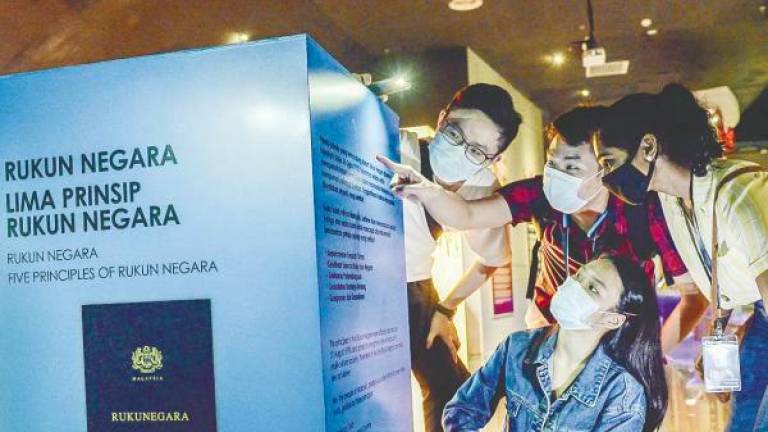KUALA LUMPUR: Exactly a week after the sudden and massive flooding on Dec 18, Taman Sri Nanding in Hulu Langat district – located about 20 kilometres from here – looked like it had been battered by a tsunami.
In front of each house, garbage and household items and furniture ruined by the floodwaters were piled up – some as high as a car.
Taman Sri Nanding was among the district’s worst-hit areas and nearly 1,000 houses were submerged in floodwaters right up to their rooftops.
Garbage trucks with roll-on/roll-off trailers could be seen entering and leaving the housing estate, leaving behind muddy trails and dust that stings the eyes.
One of the residents Saiful Bahari Mohd Bahsari, 36, a postman, told Bernama this was the first time he had experienced such severe flooding which left his house in such a bad shape that he was at a loss as to how to go about cleaning it.
“The whole housing area has become very dusty (after the floodwaters receded) and I suffer from asthma but whether I like it or not, I’ve to clean up my house... how long can I go on staying in my relative’s house?
“It’ll take some time to clean up... this is the first time a major flood had occurred here, causing severe damage. Previously, we only experienced floods where the water level went up to our knees. But this time, it rose up to our head and we rushed out with just the clothes we were wearing to save ourselves as the water was flowing swiftly and rising fast,” he said.
Journalist Nur Firdaus Abdul Rahim, 38, said as a reporter she has covered floods in the east coast states but the situation in Taman Sri Nanding was worse than what she had seen in Kelantan and Terengganu.
“The residents were just not prepared for the floods (on Dec 18). Almost all the households there lost their furniture, clothes and electrical gadgets as they were all damaged. In fact, people were even distributing women’s undergarments there... this is something that doesn’t happen on the east coast because the people there are usually well prepared to face the (year-end) floods,” she said.
Heavy and continuous rainfall over two days starting Dec 17 had resulted in severe floods – said to be the worst in 50 years – in Hulu Langat, Shah Alam, Klang and other parts of the country where thousands of people were shifted to temporary evacuation centres.
Weather updates
Prime Minister Datuk Seri Ismail Sabri Yaacob, who had described the sudden floods as unexpected unlike on the east coast where floods are an annual event, said states that don’t usually experience flooding must make the necessary preparations as soon as the Malaysian Meteorological Department (Met Malaysia) issues warnings pertaining to severe weather.
Saiful Bahari said despite the heavy losses he had incurred, the recent floods taught him the importance of heeding the warnings issued by Met Malaysia.
“I am now worried there may be a possibility of a second wave of flooding. I now realise how important it is to monitor Met Malaysia’s weather reports, as well as check the website of DID (Department of Irrigation and Drainage) because our housing area is located near Sungai Langat,” he said, adding that he also plans to buy a safety jacket so that he would be better prepared in future.
Meanwhile, following the recent floods, there has been a huge increase in the number of people visiting Met Malaysia’s website and social media accounts.
According to Met Malaysia, its social media accounts such as Facebook used to record around 100,000 visitors a day but now up to one million surfers a day are visiting the site to read the latest weather updates. The agency’s telephones have also been ringing non-stop as members of the public call to find out about the current situation.
Civil servant Ahmad Erwan Othman, 34, who has been staying in Taman Casa Lagenda in Hulu Langat since 2019, said his housing area has never been inundated before and that the recent floods took them all by surprise.
“Previously, people staying nearby would park their cars in Taman Casa Lagenda whenever floods occur as it is situated on higher ground. But this time, our area was affected as well... we never expected the water level to rise up to our head and submerge our vehicles,” he said.
He said the incident has taught him not to take things for granted and also gave him the opportunity to get closer to his neighbours, some of whom he had never met before.
He said the local community there has also proposed to buy a boat for their use in the event of a flood.
“During the recent flooding, we couldn’t leave our housing area as the access road was blocked because many cars belonging to people living in the low-lying areas nearby were parked there.
“Fortunately, mine was a double-storey house and we sought shelter on the first floor,” he added.
Train communities in flood management
Experts, meanwhile, warned that according to projections, extreme weather events in Southeast Asia, including Malaysia, are set to worsen in the future.
Climatologist Professor Dr Fredolin Tangang, from the Faculty of Science and Technology, Universiti Kebangsaan Malaysia, told Bernama the number of floods occurring in Malaysia has been on the rise since 20 years ago, with losses amounting to over RM8 billion.
Citing Kuala Lumpur as an example, he said studies have shown that the intensity of its thunderstorms and rainfall has increased by 30 percent since 30 years ago, resulting in frequent flooding.
Environmentalist Professor Dr Hafizan Juahir proposed that local communities be exposed to disaster management so that they are better prepared to face disasters and, thus, reduce the risk of loss of property and life.
“Although our rescue authorities have the necessary equipment, they have limitations too especially in terms of personnel, so it’s difficult for them to be present in all the affected areas. It’s important for members of the community to be equipped with the necessary skills and trained to manage floods in a sustainable manner,” said Hafizan, who is also director of the East Coast Environmental Research Institute at Universiti Sultan Zainal Abidin.
He believed that with the creation of communities in villages, districts and states that are equipped with the skills and resilience to face disasters, their level of preparedness will enable them to act more effectively and swiftly as soon as a disaster strikes.
He said enhancing community awareness of natural disasters should also encompass environmental care and conservation simply because the natural disasters that have been occurring of late are caused by the human factor, namely unsustainable development.
Universiti Putra Malaysia Faculty of Forestry and Environment senior lecturer Dr Mohd Yusoff Ishak, meanwhile, urged the authorities to organise a Hari Banjir or Flood Day to create more awareness on floods among the community.
“While a lot is being done to create awareness on the danger of fires, not much is being done to organise disaster or flood drills. Awareness of floods must be intensified... perhaps a flood drill or Flood Day can be organised as an official event during the National Preparedness Month in October every year,” he said.
Mohd Yusoff added that institutionalising the flood drill on Flood Day is the best way to enhance public understanding and awareness of floods. — Bernama













